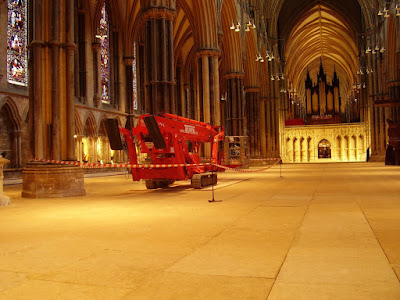 The situation we are in would naturally make some of us suicidal, but where there are people in the diocese who see this they either don’t say so or perhaps don’t quite ‘realise’ what they see.
The situation we are in would naturally make some of us suicidal, but where there are people in the diocese who see this they either don’t say so or perhaps don’t quite ‘realise’ what they see.This week we had one of the regular meetings of the Rural Deans for the northern half of the diocese. We asked about the purpose of the Candlemas Convocation and it seems I’d got the answer about right: there is an increasingly urgent message about radical change which needs to be communicated, heard and followed up. In fifteen years time, the projected number of stipendiary posts isn’t the ‘a hundred good new-style incumbents’ of The Way Ahead but something either side of half that number. At the same time, the effect of cumulative changes in attitudes in society, the use of Sunday, and the financial costs of our present structures are among many things which will make our traditional provision unsustainable anyway.
Surprise was expressed that some of us suggested that middle aged clergy felt under threat (would there be a job for us at all or which we could do in fifteen years time?) or failures (the level of collapse in numbers and structures is unfolding on our watch) or vulnerable (with everything from new competence procedures to the suspicion that there might not now be an adequate pension on which to retire). We were reassured that the main Convocation messages were precisely that the projected shortage of clergy would mean we would be in demand, the nature of the ‘paradigm shift’ around us isn’t any individual’s fault, and we should always step out in faith.
We were told about taking the Funeral of someone who had taken his own life having invested his family’s assets heavily (and on terms which required repayment over a relatively short period) in a traditionally equipped printing business just as it became apparent that the computer and digital revolution made most of such equipment and approach redundant. The conclusion was rightly drawn that we need to see the fundamental nature of the shift required of us now and act upon it. I'd have been more reassured if a further conclusion had been drawn about how some of the ones caught in this position must feel.
Having a few weeks ago got inside the joinery business in the redundant Oxford Street Mission / St Alban’s Church on the East Marsh, this week I took this blurred picture inside the removal business in the redundant St Barnabas’ Church which is next door to the Grimsby Royal Mail offices in an area depopulated in the 1960s; there are already over a dozen places in the Deanery where the Church of England has closed a church from St Mary’s in the town centre (demolished in the eighteenth century) to St Matthew’s, Fairfield (demolished this year).








